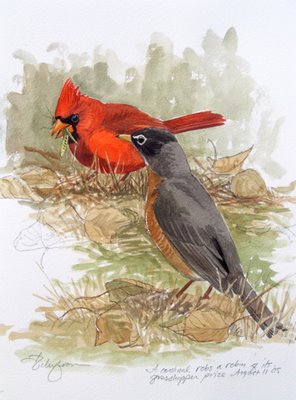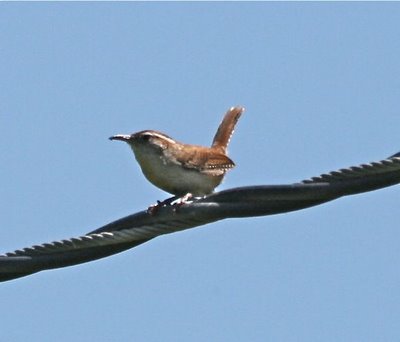Kleppers!
 I grew up watching “All in the Family” with my parents and older sister. We loved its edgy humor. In one episode, Edith Bunker (Jean Stapleton) comes home from shopping with an item she hadn’t intended to buy and never paid for, and becomes convinced that she’s a kleptomaniac. She turns to the camera, a look of abject horror crossing her face. “I don’ wanna be a kleppa!” she wails.
I grew up watching “All in the Family” with my parents and older sister. We loved its edgy humor. In one episode, Edith Bunker (Jean Stapleton) comes home from shopping with an item she hadn’t intended to buy and never paid for, and becomes convinced that she’s a kleptomaniac. She turns to the camera, a look of abject horror crossing her face. “I don’ wanna be a kleppa!” she wails.Well, I’ve been collecting incidences of kleptoparasitism here in my yard. Kleptoparasitism describes one animal stealing food from another. Cardinals, it seems, are good at it. This May, I was watching a juvenile eastern bluebird struggling with a large black beetle on the lawn beneath my studio window. An adult male cardinal flew down and displaced the bluebird, which dropped its catch. The cardinal masticated the beetle briefly, then dropped it. Perhaps it was distasteful. Perhaps the klepper cardinal was just being mean.

On August 11, 2005, in the midst of a severe drought, I was watching a robin foraging in the lawn for grasshoppers, there being no earthworms within a yard of the surface. I was feeling bad for the robin, which was processing a hard old crusty grasshopper, when an adult male cardinal came down, bumped the robin and grabbed the hopper. I commemorated that event in a watercolor. I couldn’t help but put a triumphant glint in the cardinal’s eye, and a kind of forlorn look in the robin’s, because that’s what I saw. They’re standing on crispy grass amidst birch leaves that turned brown and fell off the trees—in August.
But the third and most recent instance is my favorite. On May 28, 2008, I was sitting on the front porch, having just called my mom for her 88th birthday. I was idly watching an adult Carolina wren which was perched on the telephone wire. It had a big white moth in its bill, and it was hesitant to come to its nest, which was in a copper bucket just over my head, under the eave. As it perched there, trying to make up its mind whether to blow its cover and bring the food to its young (news flash, Mr. Wren. I put the bucket up there; I know perfectly well you have five babies in it), a large brown bird flew directly at the wren, bumped it chest to chest, and snatched the moth. The wren spiraled down to the ground, caught completely off guard. The brown bird flew right past my astonished face, and as it passed I caught bright rufous in its outer tail feathers and yellow on its belly—a great crested flycatcher! Wow!
How I wish I could have photographed the incident. I had to settle for a photo of one very pissed-off and mothless Carolina wren, who was doubtless wondering what the heck just happened. Nope, didn’t get a photo of the perp. Sorry. But maybe I'll do a painting of the chest-butting, moth-snatching flycatcher assaulting the wren. See? We'll never be able to completely replace artists.

At the risk of belaboring the obvious, I would point out that in all three instances, I was calmly watching a common bird going about its business when the kleptoparastism occurred. I was certainly not expecting such cool behavioral interactions; they were completely serendipitous. There is much to recommend watching common birds go about their business, and then making a written record of what you observe.
Because, in the words of R.T. Peterson, "If you don't write it down, it never happened."
Labels: cardinals, great crested flycatcher, kleptoparasitism





